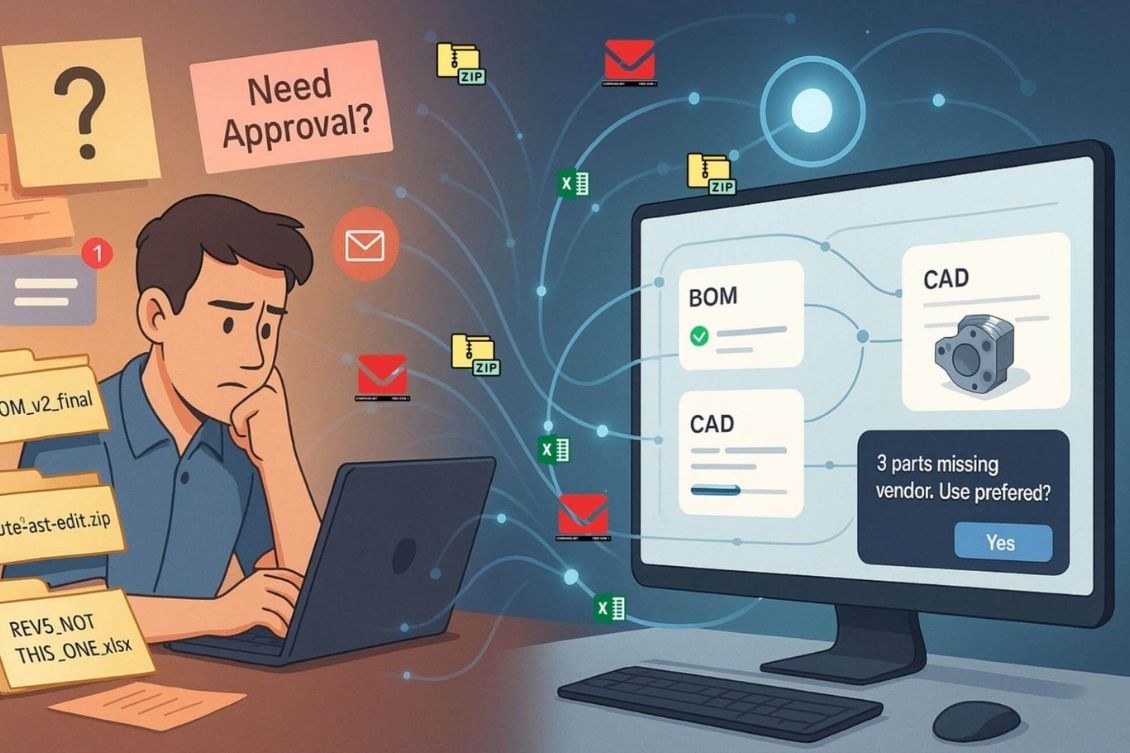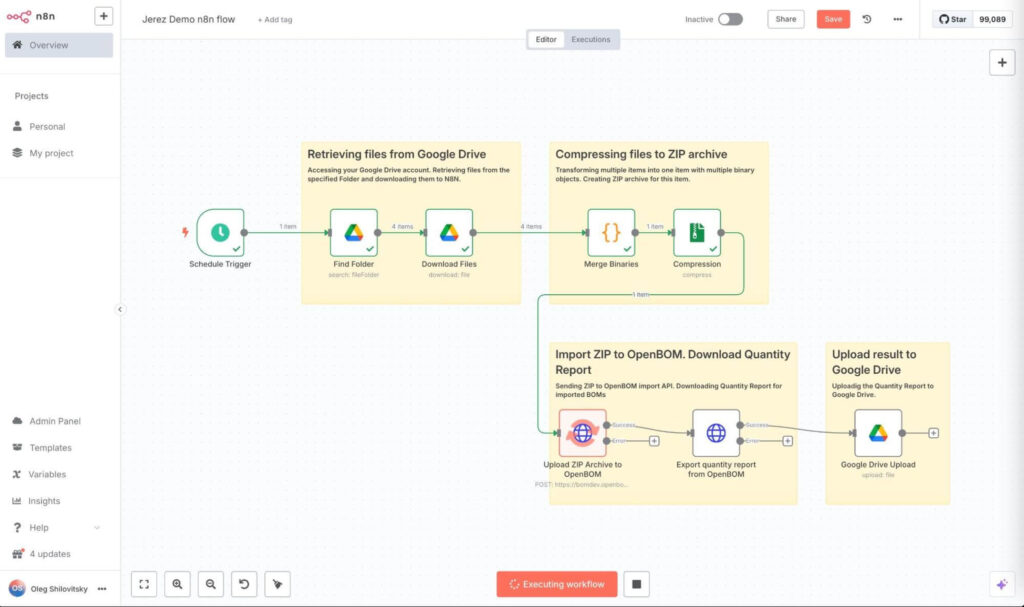
Let’s start with a familiar story. You’re trying to finalize a product quote. The design’s ready. The parts are mostly there. You just need to export the BOM, check for preferred vendors, send the RFQ, wait for responses, track approvals, sync with purchasing, update the record in your ERP, and make sure everyone’s using the right revision. Oh, and you need to do it quickly before the suppliers go on holiday.
If you’ve been in this moment, you know it’s not about engineering anymore. It’s about chasing systems, updating spreadsheets, following up on Slack, and hoping nothing slips through the cracks. And if you’re using a traditional PLM system, chances are the workflow in place wasn’t built for this kind of sprint. It was built for another world—one with perfectly aligned process charts.
At OpenBOM, we believe it’s time to reimagine what a workflow means—especially for engineers.
That’s why we’re developing a new type of Workflows for Engineers: an approach that places humans —the engineer, the designer, the decision-maker—at the center. It’s a shift from rigid, flowchart-driven systems that are only good for presentations to intelligent, supportive agents that work with you, adapt to your tasks, and stay out of your way.
The Problem with Workflows Today
The word “workflow” has become synonymous with the formal process in the PLM industry.
Click to change status.
Wait for approval.
Enter a ticket.
Ping someone to move the thing forward (because someone went on vacation).
Realize you’re waiting on a process—not progress.
Most engineering workflows aren’t really workflows at all, they’re patchworks. A BOM sent via email. A spreadsheet manually updated. A Slack message that serves as an approval. A CAD file zipped and resent because the one in the shared drive was “the wrong version.”
And the systems designed to “fix” this problem? They often introduce a new one.
Two Common (and Failed) Approaches:
- Top-down rigidity: Heavy PLM platforms that enforce a strict flow—perfect for enterprises with IT and process consultants, but totally unworkable for agile, fast-moving teams.
- Empty frameworks: Low-code tools or BPM systems that promise flexibility, but deliver blank canvases. You’re left building your own logic from scratch, with no connection to product data or understanding of engineering context.
The result? Frustration, workarounds, or worse—abandonment.
What Makes a Workflow Different? What’s the AI Agent Role?
An Agentic Workflow isn’t just a clever name. It’s a new different way of thinking about how product work happens. Instead of starting with a diagram or a rule, it starts with you – Your files. Your task.Your context.Your next move.
The AI Agent can communicate, use tools via MCP protocols and access data stored as context in structured data stories. listens, understands, and helps. It operates with files and context-aware actions that anticipate your needs and keep your work moving forward.
Here’s what that means in practice:
- You upload a file → The Agent reads it, extracts data, and builds structure.
- You send a BOM → The Agent finds missing data, suggests vendors, and makes RFQ.
- A supplier sends back a spec → The Agent compares it to the original and flags critical differences.
You update a design → The Agent checks downstream dependencies and syncs connected systems.
This is not automation that takes over. It’s assistance that empowers.
It’s GitHub Copilot for engineers, Zapier for product data, and a co-pilot for your workflow.
From Control to Collaboration
Traditional workflows are about control—systems telling people what to do. A new type of engineering workflow flips that. They’re about collaboration between you and the digital agents and tools. The Agent isn’t your manager. It’s your assistant. It watches. It learns. It nudges. And most importantly, it lets you stay in control.
You get to move fast, iterate, and adjust course—without being penalized for breaking a diagram or skipping a status. You don’t need to memorize which form to fill. You don’t need to “submit a request” to move forward. The Agent just knows what you’re doing—and helps you get to the next step.
Engineering Workflows Built for Engineers
Let’s walk through a few real-world examples.
1. CAD to Quote in Minutes
You’ve finished your design. You export a STEP file and an Excel BOM. The Agent immediately:
- Parses the data
- Builds the internal product structure
- Finds parts missing vendor information
- Notifies you: “Three parts don’t have vendors. Use the ones from your last project?”
You say yes.
The Agent fills in the data, prepares the BOM, sends an RFQ to the selected vendors, and logs all the history—no bouncing between systems, no second-guessing.
2. Change Management Without Chaos
A supplier sends a revised CAD file or point on the online CAD design link .
You upload it or extract the data online using REST API or MCP.
The Agent compares it to the current version, detects a tolerance change, and flags it:
“This affects the mating surface of sub-assembly A. Review before approving?”
You approve the change, and the Agent:
- Notifies stakeholders
- Updates records
- Logs the change trail
The work gets done. The decision is traceable. You stay focused.
3. Multi-System Orchestration
You update a BOM in Excel in OpenBOM. The Agent:
- Checks for links to a PO in NetSuite and an assembly in Onshape
- Triggers updates in each system
- Flags any inconsistencies
- Opens approvals only where needed
This isn’t “build your own integration.” It’s the system seeing what’s connected and acting accordingly.
Protocols That Speak the Language of Engineering
Agentic Workflows don’t just live in OpenBOM like all workflows in a traditional PLM systems. They extend across your ecosystem.
We built them to work with modern, accessible protocols:
- REST API – for seamless system integration
- Webhooks – trigger actions from tools like Zapier, n8n, or Make.com
- BOM MCP Server Protocol – our next-gen orchestration layer for multi-step, intelligent workflows across distributed systems and vendors
- It is compatible with various workflow engines and orchestrators (eg. N8N)

This isn’t just about better workflows within your company walls. It’s about intelligent threads that connect your suppliers, ERP, CAD systems, and project tracking—automatically and securely.
Why This Matters
Here’s the truth: engineering work isn’t linear. It’s messy. It’s iterative. It loops back on itself. It depends on conversations, gut calls, exceptions, and improvisation.
Traditional PLM workflows weren’t built for that. They were built to enforce order and process in a single organization. But that’s not how “real world” works”. Engineers need speed, flow, and clarity without friction.
And this is what we are working on at OpenBOM – a new type of Engineering Workflows.
Not Just Automation, but Assistance
Some systems chase automation for its own sake—removing humans from the loop. That’s not our goal. We believe the engineer is irreplaceable.
But we also believe engineers shouldn’t be buried in tasks like:
- Copy-pasting part numbers between tabs
- Manually renaming files
- Hunting for approvals
- Syncing emails with BOM versions
With new OpenBOM AI agent workflows, you don’t spend time “doing the process.” You just do the work. The AI Agent ensures the rest happens behind the scenes – files are uploaded, reports are generated, etc.
The Agent as a Teammate
We don’t call it “Agentic” for nothing. This is about creating a lightweight, intelligent presence that helps you—not a workflow monster that controls you.
The Agent brings:
- Memory – “Here’s what you did last time with this part.”
- Insight – “This new spec doesn’t match the previous version.”
- Foresight – “Want to alert the vendor before production?”
- Actions – “Send the updated BOMs to procurement.”
It’s like having a teammate who never sleeps, never forgets, always keeps the context close, and doesn’t require a salary to be paid.
Conclusion: From Bottlenecks to Flow
We’re entering a new era of engineering work—one where data flows, decisions are visible, and systems support people (not the other way around). Agentic Workflows are the foundation of that future.
You don’t start with a process diagram.
You don’t configure a template.
You just start working.
The Agent joins you—understands your context, helps you move forward, and stays quiet when not needed.
That’s not just a better workflow.
That’s the future of work we see it.
And we are working to deliver it at OpenBOM.
If those ideas are resonating with you, please send us a nudge. For all these years, OpenBOM has always worked closely with our customers to improve and deliver a better experience and functions for our customers.
REGISTER FOR FREE and check OpenBOM today.
Best, Oleg
Join our newsletter to receive a weekly portion of news, articles, and tips about OpenBOM and our community.










